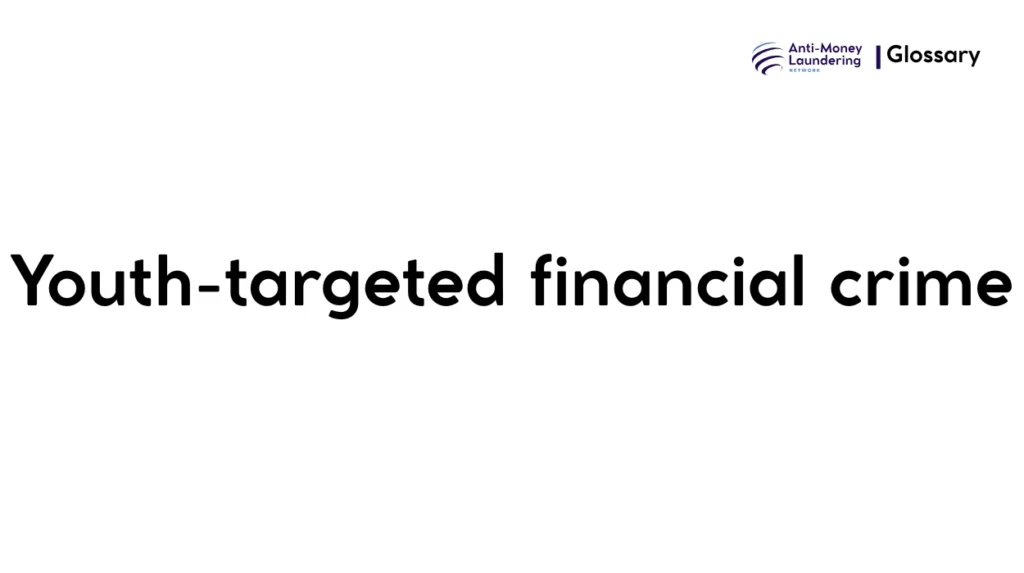Definition
Youth-targeted financial crime in Anti-Money Laundering (AML) refers to the exploitation or manipulation of minors (typically under 18 years) or young adults by criminals for the purpose of facilitating money laundering activities. This involves coercing, deceiving, or grooming young individuals to unwittingly or knowingly move illicit funds through bank accounts, digital wallets, or other financial products, thereby obscuring the illegal origins of the money.
Purpose and Regulatory Basis
Youth-targeted financial crime matters critically in AML because young individuals are often more vulnerable to exploitation due to their limited financial knowledge, social pressure, or coercion. Criminal networks exploit this vulnerability to create “money mules” or facilitate layering and integration stages of money laundering, undermining the integrity of financial systems.
Key global and national regulations addressing this include:
- Financial Action Task Force (FATF) recommendations which emphasize vulnerability assessments and protecting at-risk groups including youth.
- USA PATRIOT Act, which imposes strict Customer Due Diligence (CDD) and monitoring obligations, requiring vigilance for signs of exploitation.
- European Union Anti-Money Laundering Directive (AMLD) which mandates enhanced due diligence measures for vulnerable populations.
- Regulatory guidance such as the UK’s Money Laundering Linked Financial Exploitation framework that specifically highlights exploitation of children in money laundering schemes.
When and How it Applies
Youth-targeted financial crime comes into play primarily when a young person’s account or financial identity is used to transfer or layer illicit funds. Real-world scenarios include:
- Criminal groups recruiting young people online or in person to use their accounts for moving criminal proceeds.
- Young victims coerced into opening accounts specifically for criminal use or handing over control of existing accounts.
- Exploitation occurring alongside other criminal activities such as drug trafficking or fraud.
Triggers for relevant AML controls include unusual transaction patterns involving youth accounts, unusual account ownership changes, or reports of coercion from law enforcement or community sources.
Types or Variants of Youth-Targeted Financial Crime
Variants include:
- Involuntary Money Mules: Minors unknowingly used by criminals to move money.
- Voluntary Participants: Youth recruited with promises of financial gain but lacking full awareness of illegality.
- Coerced Victims: Individuals forced or threatened into participation.
Examples include scenarios where a teenager’s bank account is deliberately used to receive and transfer funds from illicit sources or where young people are lured into cryptocurrency scams facilitating layering.
Procedures and Implementation
Financial institutions must implement layered controls to identify and prevent youth-targeted financial crime:
- Risk-Based Customer Due Diligence (CDD): Enhanced verification for accounts held by minors or young adults, including monitoring for unusual activity.
- Transaction Monitoring Systems: Automated flags for transactions inconsistent with typical youth financial behavior.
- Training Frontline Staff: Equip personnel to recognize grooming, coercion, or account misuse signs.
- Collaboration with Law Enforcement and Child Protection Agencies: Sharing intelligence and alerts related to suspicious activity involving youth.
- Account Controls: Restrictions or additional authentications for minors when opening accounts or conducting transfers.
Impact on Customers/Clients
From the customer’s perspective, particularly youth, impacts include:
- Enhanced scrutiny during account opening and transaction lifecycles.
- Potential restrictions on account usage to prevent exploitation.
- Right to privacy balanced against protective AML measures.
- Need for sensitive communication about suspicious activity with empathy for vulnerability.
Duration, Review, and Resolution
Institutions are required to:
- Continually monitor youth accounts for the duration of the relationship.
- Conduct periodic reviews, especially when risk indicators or alerts are detected.
- Coordinate with regulators and authorities to resolve cases of suspected exploitation.
- Close or freeze accounts if confirmed misuse is detected while safeguarding the rights of the youth involved.
Reporting and Compliance Duties
Institutions must:
- File Suspicious Activity Reports (SARs) promptly when youth-targeted financial crime is suspected.
- Maintain detailed records of customer interactions, due diligence, and monitoring activities.
- Ensure compliance with all regulatory reporting deadlines and cooperate in investigations.
- Implement internal controls and audits to detect possible failures in preventing youth exploitation.
- Failure to comply may result in regulatory penalties, reputational damage, and legal consequences.
Related AML Terms
Youth-targeted financial crime is closely linked with:
- Money Mules: Individuals used to transfer illicit funds, often targeted if vulnerable.
- Financial Exploitation: Broader concept including abuse of vulnerable individuals for financial gain.
- Customer Due Diligence (CDD): The process of verifying identities, critical to identifying at-risk youth.
- Transaction Monitoring: Systems designed to detect suspicious financial behaviors.
Challenges and Best Practices
Challenges:
- Detecting subtle signs of coercion or exploitation among youth.
- Balancing privacy and protection rights.
- Managing sophisticated criminal tactics using digital and crypto platforms.
- Ensuring staff are adequately trained and aware.
Best Practices:
- Employing advanced analytics and AI-driven transaction monitoring.
- Establishing clear protocols for handling suspected youth exploitation.
- Liaising closely with social services and law enforcement.
- Ongoing education of customers, especially youth, about financial risks and exploitation.
Recent Developments
- Greater regulatory focus on protecting vulnerable populations including youth.
- Increasing use of artificial intelligence and machine learning to detect suspicious patterns involving youth accounts.
- Development of public-private partnerships to combat youth exploitation in money laundering.
- Enhanced guidance from bodies like FATF emphasizing social factors in AML risk.
Youth-targeted financial crime in AML highlights the exploitation of young individuals to facilitate money laundering. Financial institutions must recognize the unique risks, implement vigilant controls, collaborate with authorities, and balance protective measures with customer rights. This focus is crucial to safeguarding vulnerable youth and maintaining the integrity of financial systems in compliance with global regulations.

